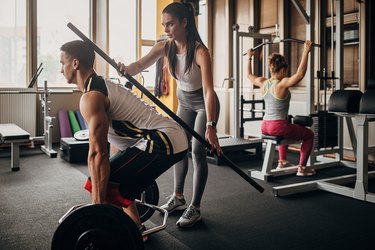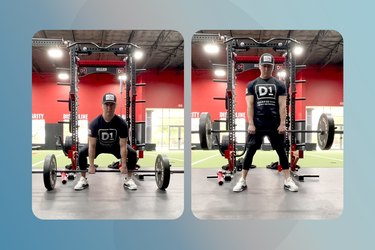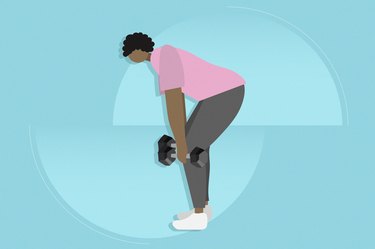

The deadlift is much-beloved exercise for a reason: Do the move right and you can work all your major muscle groups in a single rep. "It is the best head-to-toe, total-body strength builder," says Greg Pignataro, CSCS, a certified strength and conditioning specialist.
Plus, deadlifts teach you how to safely lift heavy objects off the floor, so when it comes time to move a couch or pick up a heavy box, you can manage it and still get out of bed the next day.
Video of the Day
Unfortunately, many people miss out on these deadlift benefits, and their reps create more problems than they solve — mainly, nagging lower back pain and injury. But actually, this exercise can (and for some, should) be used as a preventative measure against lower back pain, according to a July 2015 study in the Journal of Strength and Conditioning Research.
For the most effective, pain-free lifts, avoid these five common deadlift mistakes.
1. Not Squeezing Your Lats
Your lats (aka latissimus dorsi) are large, fan-shaped muscles that extend from your shoulders to your pelvis. You might not think of your lats as important in an exercise like the deadlift, but they're key for getting that weight safely off the floor, according to Brian Schwabe, DPT, CSCS, a California-based physical therapist.
When your lats aren't working, your arms start to loosen up while you lift the weight, causing your lower back to do too much work, he says. That's often a reason why your lower back might start to feel sensitive during the exercise.
Fix It
To really fire up your lats and avoid this common deadlift mistake, imagine you’re squeezing a towel under your armpits, and hold that towel in place while you perform the deadlift, Schwabe says. Think about putting your shoulder blades in your back pockets.
If you still struggle to engage your lats, try this drill: Stand with your back against a wall. Place your palms against the wall and push as hard as possible while breathing out. This can help you feel those muscles.
2. Starting With a Rounded or Arched Lower Back
There could be any number of reasons why your back arches or rounds at the start of the deadlift, but one common reason is not using your legs enough. When you don't let your legs take part in the exercise, your back muscles kick in to compensate, which can cause your back to arch or round over.
Another reason why your back might arch is because you're not engaging your core, according to Jereme Schumacher, DPT, a California-based physical therapist.
Fix It
Concentrate on pushing into the floor with your feet when you pull the weight off the ground, Schwabe says. This can ensure your legs are helping lift the weight up.
Also tuck your pelvis just a bit to help prevent your lower back from arching. Once you find that position, focus on bracing your core like you're doing a plank.
3. Pushing You Hips Too Far Forward
Schwabe sees this deadlift mistake happen a lot with people who are new to the move: arching the lower back or pushing the pelvis into the barbell in an attempt to lock-out at the top of the deadlift. But if you arch your back, you unload all that weight onto your lower-back muscles, he says. Ouch!
Fix It
Don't force your pelvis forward after you've already stood up. Squeeze your glutes instead of arching your lower back to ensure your hips are extending properly at the top of the lift, Schwabe recommends.
Make it your goal to be standing up as tall as possible at the top of the move.
4. Squatting Your Deadlift
According to Schwabe, many people who get back pain from deadlifts make the mistake of trying to squat the weight off the floor.
Unlike a squat, the deadlift relies on a hip hinge, in which you bend your hips as much as possible — and barely bend your knees — to sit your butt back. If you bend your knees too much during a deadlift, your hips wind up sitting too low, which is not only inefficient, but it places more stress on your lower back.
Fix It
When you set up for the deadlift, be sure to bend at the hips first, while pushing them back. After your hips are bent, let your knees bend only as far as is needed to grip the barbell. Keep your spine neutral and shins vertical.
5. Pulling the Weight Too Quickly
Unlike the squat or bench press, with the deadlift, you have to build up enough force to overcome gravity so you can lift a (usually heavy) object off the floor. However, many people make the mistake of thinking they have to yank that weight off the floor to overcome gravity.
"It's almost like they're trying to start a lawn mower with both hands," Pignataro says. But yanking that weight off the floor can put you in an awkward position, because once you lift the weight a couple of inches, you have to be able to control it. If you can't, you risk hurting yourself.
Fix It
Squeeze the bar as hard as you can, engage your lats (squeeze that towel in between your armpits!), take a deep breath, brace your core and squeeze your lats to slowly lift the barbell about an inch off the floor.
Keep the tension in your upper body so you can avoid taking slack out of the bar and losing control of the weight.
“Once it comes off the floor, then you can accelerate and try to stand up as quickly as you can, but it’s going to be a lot safer and more effective if, for that first inch off the ground, the barbell comes off the floor in a more controlled manner,” Pignataro says.
6. Holding the Weight Away From Your Legs
Another common deadlift mistake Schumacher sees is holding the weight too far in front of the body. This shifts your center of gavity, and dumps the weight smack dab into your lower back.
When you keep the weights close to your legs, you keep the weight where you want it: on your glutes and hamstrings.
Fix It
Imagine you're painting your legs with the weight to keep it about an inch or two of your body, Schumacher says. Keeping your lats engaged here will help!
In some cases, pushing your glutes farther back can also help prevent your body from leaning too far forward. Imagine pushing a door closed with your butt as you lower the weights.
7. Standing With Your Feet Too Wide
When you place your feet too wide on the ground, you have less control and stability over the weight, making injury a higher risk, according to Schumacher. The wider your legs, the less force you can produce, too, which means you can't lift as much weight.
Fix It
Ideally, you want to place your feet no farther than shoulder-width distance, Schumacher says. But the best foot placement varies from person to person, depending on your height and leg length. Take some time to experiment with different foot placements before you start lifting.
A simple way to find your best foot placement? Jump as high as you can. Wherever your feet land is your power stance.
How to Deadlift With Perfect Form
Barbell Deadlift
- Walk up to the bar so your shins are touching or just about touching the bar, feet about hip-width apart.
- Before bending down to pick up the weight, start by standing tall with your hands hanging down by your sides. Think about creating a solid connection between your core and hips so that your ribs are not in a flared position and your back is not arched or curved.
- Next, hinge forward and push your hips back toward the wall behind you. At the bottom position, your hips should be above your knees and your shoulders above your hips. Your shins should be fairly vertical.
- Grip the bar with both hands and pack your shoulders back and down.
- Bracing your core and maintaining a neutral spine, lift the weight off the ground. Think about pushing the floor away from you. Squeeze your glutes at the top.
- Pause, then lower the bar back to the floor using the same hip-hinge motion, pushing your hips back and keeping your back flat.
Additional reporting by Bojana Galic.
Was this article helpful?
150 Characters Max
0/150
Thank you for sharing!
Thank you for your feedback!


